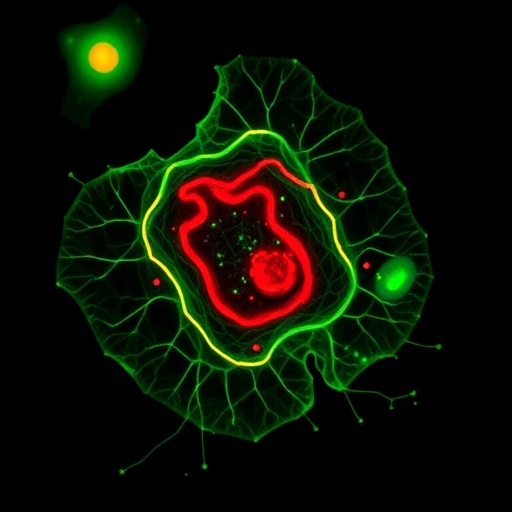In a groundbreaking study published in Nature Communications, researchers have pushed the boundaries of cardiac biology by employing cutting-edge single-nuclei multiomics technology to unravel the complexities of heart development in mice. This pioneering effort illuminates previously unrecognized populations of abnormal cardiomyocytes, offering fresh insights into the cellular and molecular underpinnings that govern cardiac formation and potential pathways to congenital cardiac disorders.
The heart is a remarkably intricate organ whose development orchestrates a synchronized ballet of cellular differentiation, proliferation, and maturation. Despite decades of research, the molecular heterogeneity and developmental dynamics of cardiac cells remain only partially understood, particularly at the single-cell level. Traditional bulk tissue analyses fail to capture the nuanced genetic and epigenetic landscapes that shape cardiomyocyte identity and function. In this study, Leonard and colleagues leverage single-nuclei multiomics — an integrative approach combining transcriptomic and epigenomic profiling within the same nucleus — to dissect this complexity with unprecedented resolution.
By isolating and analyzing individual nuclei from the developing murine heart, the team bypasses challenges associated with whole-cell dissociation, which can introduce bias and loss of fragile cell types. Single-nuclei RNA sequencing (snRNA-seq) paired with chromatin accessibility assays such as ATAC-seq allows the researchers to simultaneously profile gene expression and regulatory element activity. This multi-layered data illuminates the molecular states of cardiomyocytes as they evolve during embryonic development, revealing not only canonical cell populations but also aberrant subtypes that have escaped notice in prior studies.
.adsslot_BI40z3W6JA{ width:728px !important; height:90px !important; }
@media (max-width:1199px) { .adsslot_BI40z3W6JA{ width:468px !important; height:60px !important; } }
@media (max-width:767px) { .adsslot_BI40z3W6JA{ width:320px !important; height:50px !important; } }
ADVERTISEMENT
A key strength of this study lies in its integration of multiomic datasets, which paints an integrated portrait of gene regulatory networks operating within individual nuclei. The authors meticulously chart the dynamic interplay between transcription factors, enhancer elements, and downstream effectors that collectively orchestrate cardiomyocyte identity. By charting these regulatory circuits over developmental time, the research delineates the continuum from early progenitors to fully differentiated cardiomyocytes and highlights the point at which aberrant cells diverge from normal developmental paths.
The utility of the murine model enables experimental precision and genetic manipulation possibilities that are challenging in human studies, yet the researchers note the translational relevance of their findings. The abnormal cardiomyocyte populations they describe may serve as early biomarkers or therapeutic targets for congenital heart anomalies in humans. Furthermore, the multiomic atlas produced lays a critical foundation for comparative analyses with human cardiac development and disease.
Beyond developmental biology, this study has profound implications for regenerative medicine and cardiac repair strategies. Understanding the epigenetic roadblocks that prevent cardiomyocytes from reaching full maturity or adopting normal function could inform protocols to generate more physiologically accurate cardiac cells from stem cells. This knowledge is essential as the field pursues cellular therapies aimed at repairing damaged heart tissue post-infarction or in degenerative conditions.
The study further underscores the importance of chromatin architecture in cardiac biology. Alterations in chromatin accessibility patterns highlight regulatory regions potentially implicated in faulty gene expression within abnormal cardiomyocytes. These “epigenetic scars” could explain persistent dysfunctions that are not apparent from RNA profiles alone, emphasizing the value of capturing multiple omic layers simultaneously.
Another notable aspect is the temporal resolution achieved. By profiling cardiac nuclei across distinct developmental stages, the researchers capture the dynamic progression of cardiomyocyte differentiation and uncover transient cellular states previously invisible to snapshot analyses. These fleeting cell populations and regulatory shifts provide clues about the molecular checkpoints critical for normal heart development.
The prospect that abnormal cardiomyocyte phenotypes emerge from disrupted gene regulatory networks rather than simple genetic mutations aligns with an emerging paradigm that epigenetic and transcriptional misregulation underlie many congenital diseases. This points toward potential interventions aimed at modulating chromatin states or transcription factor activity as therapeutic avenues, a concept that warrants further experimental exploration.
The implications of this work extend into systems biology, highlighting how multiomic single-cell approaches can redefine our understanding of organogenesis. By integrating diverse molecular modalities, researchers can not only catalog cell types but also infer causal relationships and regulatory hierarchies that coordinate development at the single-cell level. This integrative perspective is poised to revolutionize biomedical research across multiple organs and disease contexts.
In summary, Leonard et al.’s study represents a landmark advancement in cardiac developmental biology, powered by innovative single-nuclei multiomics technology. The identification of abnormal cardiomyocytes and their unique molecular signatures provides a valuable framework for understanding congenital heart defects and opens new pathways for therapeutic intervention. As single-cell and multiomic methodologies continue to evolve, their application to complex developmental systems promises to unlock the secrets of human biology with transformative impact.
This research not only enhances our grasp of heart development but also exemplifies the synergistic power of combining genomics and epigenomics at single-cell resolution. The field eagerly anticipates follow-up studies that will expand these findings into human tissues and explore the mechanistic underpinnings of abnormal cardiomyocyte emergence. The marriage of technology and biology witnessed here charts a bold course for future discoveries in regenerative medicine and developmental pathology.
By illuminating the molecular choreography underlying normal and abnormal cardiomyocyte differentiation, this study provides a treasure trove of information for scientists and clinicians alike. It sets a high bar for multiomic investigations and underscores the necessity of integrated, high-dimensional data to fully delineate cellular states during organogenesis. The heart, with its unmatched complexity and vital function, remains a captivating frontier in biomedical exploration — one now seen with sharper clarity thanks to this exemplary work.
Subject of Research: Cardiac development and identification of abnormal cardiomyocyte populations in a murine model using single-nuclei multiomics analysis.
Article Title: Single-nuclei multiomics analysis identifies abnormal cardiomyocytes in a murine model of cardiac development.
Article References:
Leonard, R., Zhao, Y., Eliason, S. et al. Single-nuclei multiomics analysis identifies abnormal cardiomyocytes in a murine model of cardiac development. Nat Commun 16, 6947 (2025). https://doi.org/10.1038/s41467-025-62208-9
Image Credits: AI Generated
Tags: abnormal cardiomyocytes in micecardiac cell differentiation and maturationcardiac development researchcongenital cardiac disorders insightsgene expression and regulatory pathwaysinnovative approaches in cardiac researchmolecular heterogeneity in cardiomyocytesmurine heart cell analysisNature Communications studysingle-cell level cardiac biologysingle-nuclei multiomics technologytranscriptomic and epigenomic profiling





